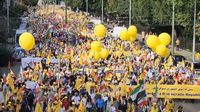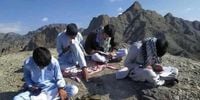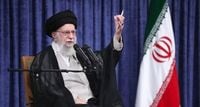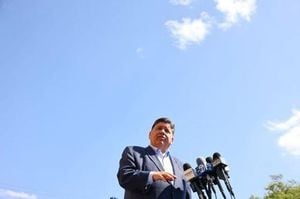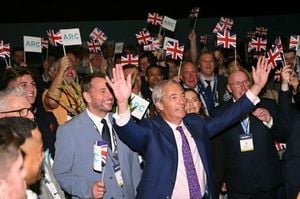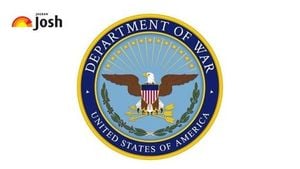On September 6, 2025, a sea of Iranian flags and placards unfurled beneath the Atomium in Brussels, as tens of thousands of Iranians and their allies gathered in a defiant rally for change. The event, dubbed the Free Iran Rally, marked both a crescendo of international opposition to Iran’s theocratic regime and the 60th anniversary of the People’s Mojahedin Organization of Iran (PMOI/MEK), a group that has spent decades resisting dictatorship in its homeland. Organizers estimated turnout at several tens of thousands, while police put the figure at around 10,000. The demonstrators’ message was clear: it’s time for the European Union to get tougher on Tehran.
Among the prominent figures addressing the crowd were Maryam Rajavi, President of the National Council of Resistance of Iran (NCRI), former U.S. Vice President Mike Pence, former Belgian Prime Minister Guy Verhofstadt, and John Bercow, the former Speaker of the U.K. House of Commons. Each lent their voice to calls for democracy, human rights, and a firmer European stance against the Iranian regime. “We are here to make our voices heard and to support Mrs. Rajavi in her fight for democracy in Iran,” Afchine Alavi, spokesperson for the NCRI, told reporters, according to the Brussels Times.
Protesters demanded that the European Union enact new sanctions against Tehran and designate Iran’s Revolutionary Guards (IRGC) as a terrorist organization. Their banners and chants echoed a litany of grievances: political repression, executions, environmental neglect, and a faltering economy. Yet at the heart of the rally was a celebration of the PMOI’s six decades of struggle—14 years under the Shah’s dictatorship, and 46 under the rule of the Islamic Republic.
Maryam Rajavi, addressing the crowd, reflected on the organization’s history: “Sixty years since the day the People’s Mojahedin Organization of Iran was founded. Fourteen years under the Shah’s dictatorship, and forty-six years under the religious dictatorship. Sixty years, without a single day or even an hour of pause. It may be hard to believe, but it is the absolute truth. That is why today, the PMOI lights sixty shining flames—flames that can never be extinguished.” She honored the memory of martyrs like Ahmad Rezaii, the group’s first, and the most recent, Behrouz Ehsani and Mehdi Hassani, whose 40th day of martyrdom was marked on September 5, 2025.
Inside Iran, the PMOI’s network of so-called “Resistance Units” has continued to challenge the regime, even as it faces an escalating campaign of repression. On September 5, these units staged acts of defiance in Zahedan, brandishing placards and slogans to mark the organization’s anniversary. Such demonstrations, though small compared to the Brussels rally, carry enormous risk. Less than two months ago, the regime executed PMOI members Behrouz Ehsani and Mehdi Hassani; 14 others remain on death row, and crackdowns on their families have intensified. According to the National Council of Resistance of Iran, the regime is also attempting to erase its history of crimes by destroying the gravesites of martyrs.
This campaign of erasure is not limited to the PMOI. Satellite images from August 2025 revealed that Lot 41 at the Behesht-e Zahra cemetery in Tehran—a mass grave for thousands executed after the 1979 Revolution—was being paved over to make way for a parking lot. According to Planet Labs PBC and corroborated by Shargh, Iranian officials have acknowledged the project, which overlays the remains of regime opponents and ordinary citizens alike. The United Nations special rapporteur described such destruction as an attempt to “conceal or erase data that could serve as potential evidence to avoid legal accountability.” Shahin Nasiri, a University of Amsterdam lecturer who has studied Lot 41, noted that “most of the graves and gravestones of dissidents were desecrated, and the trees in the section were deliberately dried out. The decision to convert this section into a parking lot fits into this broader pattern and represents the final phase of the destruction process.”
Human rights activists argue that this is part of a decades-long pattern of impunity and denial. Hadi Ghaemi, executive director of the Center for Human Rights in Iran, linked the current crackdown to a grim history: “There is a direct line between the massacres of the 1980s, the gunning down of demonstrators in 2009, and the mass killings of protesters in 2019 and 2022.”
Meanwhile, the regime faces mounting crises on multiple fronts. Iran’s Supreme Leader, Ayatollah Ali Khamenei, recently lamented the country’s low oil production and outdated methods, calling for diversification of export markets. “Oil production in the country—with the importance it has in the economy, which is obvious—is low. Our oil production methods are old methods; the tools are old… We are behind many of the oil-rich regions of the world,” Khamenei told his cabinet, according to AFP. About 92% of Iran’s oil is sold to China, often at deep discounts, while relations with Europe have soured further. In August, Britain, France, and Germany triggered the “snapback” mechanism under the 2015 nuclear deal, reimposing UN sanctions due to concerns over Iran’s nuclear program. Iran responded by halting cooperation with the International Atomic Energy Agency (IAEA) after a 12-day war with Israel, during which its nuclear facilities were struck.
Foreign Minister Abbas Araghchi, writing in The Guardian, insisted that “Tehran remains open to diplomacy and there is still time—and a dire need—for an honest conversation.” Yet, with high-stakes meetings in Doha and Vienna and a looming deadline for sanctions, Tehran’s options appear limited.
Back home, everyday Iranians are grappling with deepening social and economic woes. On September 7, Iran’s Minister of Education Alireza Kazemi revealed that approximately 950,000 children and teenagers are deprived of education or have dropped out of school. That number could be as high as two million, according to a parliamentary commission member, with economic hardship and child labor cited as primary causes. Kazemi acknowledged in an interview with ILNA that “part of the decline in educational quality directly relates to the Ministry of Education itself,” pointing to overcrowded classrooms, smartphone dependency, family-school disconnection, language gaps, and inadequate preschool coverage as key factors. Gholamali Afrooz, a professor at Tehran University, noted that only 70% of Iranian students who enter elementary school eventually graduate from high school, with 30% leaving early to join the labor market.
Environmental concerns add yet another layer to the crisis. Seven years after Iran’s Clean Air Law was passed, pollution in cities like Tehran remains at dangerous levels. Shina Ansari, Vice President and Head of the Department of Environment, admitted to ISNA on August 24 that “many of the obligations under the Clean Air Law remain unfulfilled.”
Against this backdrop of repression, economic hardship, and environmental decline, the Brussels rally became more than just a protest—it was a declaration of hope and a call for accountability. As the crowd dispersed under the shadow of the Atomium, their chants lingered: a reminder that, for many Iranians, the struggle for freedom and justice is far from over.
